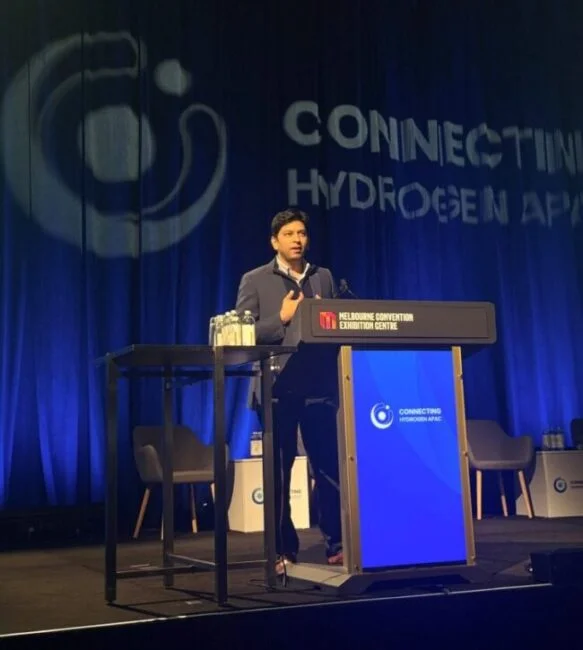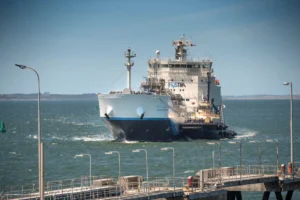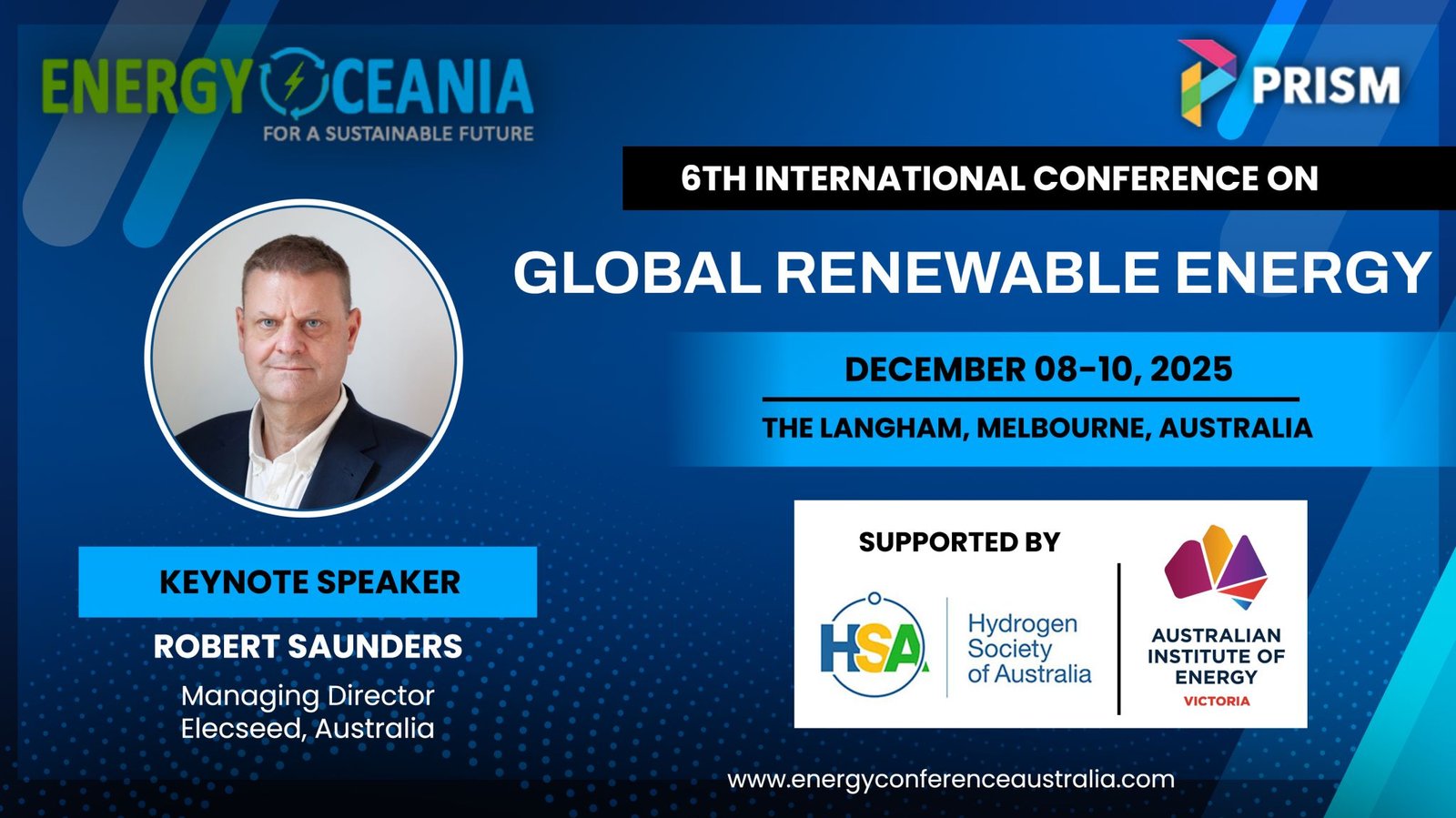“Hydrogen’s future is still uncertain, but its potential remains unmatched.”
AuWE 2025 Connecting Green Hydrogen APAC Conference Melbourne.
By SCOTT PODMORE
Nikunj Panchal, a global Vice President at Ricardo with over 25 years of experience across energy sectors in the UK, Norway, India, Australia among other countries, stood before a full house of industry leaders and policymakers at last Friday’s Melbourne 2025 Connecting Green Hydrogen APAC conference.
His message was clear, candid, and deeply rooted in decades of strategic infrastructure and investment insight: hydrogen’s future is still uncertain, but its potential remains unmatched.
With a Chemical Engineering degree and an MBA, Panchal has advised on public-private transition strategies across hydrogen, ammonia, and circular economy infrastructure. His keynote, titled Navigating Hydrogen Through Uncertain Times, aimed not to provoke controversy, but rather to speak the hard truths about hydrogen’s stalled momentum — and what it will take to fix it.
Setting the Scene: A Growing Gap Between Aspiration and Action
Panchal opened with a dose of realism that many in the audience no doubt shared.
“If I say hydrogen is doing great, some of you will be upset. If I say it’s not doing great, others will be just as unhappy,” he points out, smiling. “So let me take the middle ground… these are uncertain times.”
Drawing from Ricardo’s PROMETHEUS scenario data, Panchal highlighted the stark contrast between current policy trajectories and what is needed to meet net-zero goals. The data showed that under present global policies, hydrogen demand in 2050 may only reach less than 10% of the volume required in a net-zero scenario.
“It’s not that hydrogen isn’t happening,” he says. “It’s just not happening fast enough.”
The International Energy Agency’s (IEA) latest outlook confirms this: if every hydrogen project with Final Investment Decision (FID) were completed, global capacity would still only rise to 7.5 million tonnes by 2035. That’s a fraction of what’s needed.
The Investment Reality: A Sobering Disparity
Hydrogen’s investment momentum, while growing, still lags significantly behind other energy sectors.
“Global clean energy investment reached $2.1 trillion in 2024, but hydrogen attracted just 2–3% of that,” Panchal says. “That tells you the story.”
While hydrogen investment grew 60% year-on-year — a seemingly positive trend — only 4–5% of projects have reached FID. That leaves the bulk of projects either stalled or cancelled due to unresolved policy, funding, or infrastructure barriers.
This funding bottleneck, Panchal explains, reflects broader energy transition dynamics. “We’re witnessing a shift from sustainability-driven investment to one led by energy security and affordability,” he said, referencing the ongoing energy trilemma.
The Chasm and the Hype: Why Hydrogen May Be Stuck
One of the presentation’s most visually striking moments came with the familiar “Technology Adoption Curve” — this time with hydrogen poised ominously in “The Chasm.” That’s the perilous phase between early adoption and mainstream scaling.
“Many projects with FIDs have been cancelled globally in the past two years,” Panchal notes. “And the withdrawal of incentives in the U.S. has been a major setback for the hydrogen value chain.”
The implication? Hydrogen risks stalling unless urgent action bridges the gap between visionary pilots and viable, commercial-scale deployment.
Emerging Trends: Energy Geopolitics and Trade Realignment
Panchal then zooms out to explore geo-economic dynamics shaping hydrogen’s trajectory.
“Energy-rich regions like the Middle East, Australia, and parts of Africa are defining new trade routes,” he explains. “But energy-resource-constrained economies are trying to redefine dependencies, and that’s creating friction.”
He argues that Energy Security, trade deficits, and long-term supply chain dependencies are driving a reshuffling of global alliances and investment priorities.
“These macroeconomic shifts must be considered when developing bilateral hydrogen strategies — especially for regions like Southeast Asia, which have export-oriented ambitions.”
Three Pillars of Misalignment
Panchal outlines a fundamental flaw: despite enthusiasm and efforts, three key stakeholder groups remain out of sync:
- Public Sector – “Policies have improved, but there’s a major gap in multi-regional coordination and permitting reform.”
- Corporate & Industry – “Many projects struggle with infrastructure readiness, demand signals, and long-term off-take visibility.”
- Financial Institutions – “The return on investment is unclear, and offtake uncertainty continues to be a dealbreaker.”
“Unless these three players align,” Panchal warns, “we’ll remain stuck in feasibility purgatory.”
From Floodgates to Focus: Prioritization Over Proliferation
A major point of frustration, Panchal said, is the “floodgate effect”: too many projects chasing limited funding, without a coherent national or regional prioritization framework.
“We need a stage-gated approach,” he urges. “For example, governments should commit to building 2 GW-scale projects by 2035, 5 GW by 2040, and 10 GW by 2050. That sets the tone.”
This type of strategic focus could help regulators, funders, and developers align infrastructure support and funding mechanisms more efficiently. Without prioritization, the entire system runs the risk of “getting clogged”.
The Policy Imperative: Stability, Simplicity, and Sovereignty
Panchal also issues a strong call for policy clarity and continuity.
“Policy flip-flops with changing governments destroy momentum and investor confidence,” he says. “We need cross-party, long-term commitments to hydrogen.”
He also emphasized the need for simplified permitting: too many projects “take longer to permit than to build”. A fair criticism echoed by many developers in the room.
International coordination is also essential.
“Australia has a pivotal role to play with Japan and Singapore. Bilateral policy alignment is critical if export projects are to succeed,” Panchal points out.
Fixing the Funding Framework: From Stack to Shared Profit
The current investment model, Panchal explains, often leads to a “stacked profit” approach — with each layer (OEMs, EPCs, SPVs) taking a cut. This inflates CAPEX and reduces bankability.
“The solution? Move to a shared profit model. Bring offtakers and OEMs into the project structure,” he said. “When everyone has skin in the game, project risk is reduced, and delivery becomes more predictable.”
He also stressed the importance of cost transparency, especially for high-cost components like electrolysers: “In some cases, the price has doubled in two years. We need clarity.”
Infrastructure: The Elephant in the Room
“Most projects don’t fail because they’re bad ideas,” Panchal said. “They fail because infrastructure isn’t there.”
Hydrogen’s reliance on high volumes of renewable power, water, and port access creates huge logistical challenges. “You can generate all the solar and wind you want —but if it’s not connected to the grid, it’s useless.”
He also pointed out that co-locating hydrogen facilities with existing infrastructure (steel mills, refineries, export terminals) can accelerate deployment. “Projects that have done this are the ones that have made it past FID,” he says.
To conclude, Panchal outlined his three-stage roadmap to move hydrogen from promise to performance:
- Access – Secure access to infrastructure, supply chain, and funding.
- Action – Take decisive steps on prioritization, off-take guarantees, and policy alignment.
- Accelerate – Fast-track projects, build confidence with financiers, and scale proven models.
“It’s going to take commitment, collaboration, and cultivating a new project culture,” he says. “But if we get this right, hydrogen won’t just emerge. It will thrive.”
Final Verdict: Poised Between Potential and Paralysis
Nikunj Panchal’s presentation was anything but optimistic fluff. It was a clear-eyed analysis of hydrogen’s promise — and its perils. With the right policies, funding structures, and global coordination, hydrogen still holds the power to reshape global energy systems.
But time is running short. The technology is ready. The capital exists. What’s needed now is alignment, execution, and vision.
As Panchal put it best: “Hydrogen will emerge eventually. But the way we manage access, action, and acceleration will determine how fast — and how successfully — it does.”
READ MORE ABOUT: Nikunj Panchal is Ricardo’s Global Vice President of Energy, Infrastructure Transition. HERE+
ABOUT RICARDO: 110+ Years as a Global engineering consulting services and solutions built on sustainable technological innovation. HERE+















